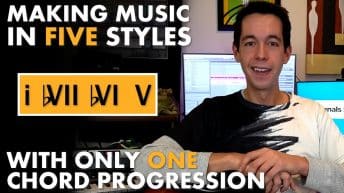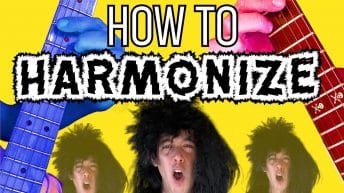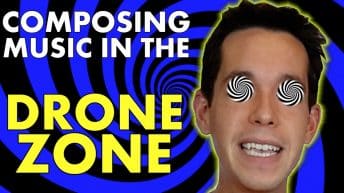This video is a fun demonstration of how to write a modern sea shanty, or pirate-themed song. Real shanties are much richer in history and form than what we’ll discuss here, which is the popularized version of the tradition. That means we’re going to learn to write music that sounds more like what you’d hear in a Pirates of the Caribbean movie, and less like the actual working songs or “chanteys” of yore.
The song you hear at the beginning of this video is a good demonstration of the techniques you’ll learn to use. Below is a short summary of what’s shown inside.
Rhythmic Considerations
Perhaps the most important element in making a song sound pirate-themed is the rhythmic structure. This genre tends to avoid straight steady pulses (like eighth notes in 4/4), and instead relies on “shuffled rhythms,” swung beats, and 6/8 or 12/8 time. Writing in 12/8 is as simple as writing in 4/4 but filling every measure with 8th note triplets. This creates the 12/8 feel, and also promotes the swung/shuffled 8th notes that fit into that rhythmic grid.
Shuffled beats have more motion than regular eighth notes. Compare straight eighth notes to shuffled ones and you’ll immediately hear the “beer sloshing effect” that makes it sound more piratey. In addition, 6/8 and 12/8 patterns can enhance a folksy/adventurous sound, as opposed to the driving energy that straight eighth notes promote.
Chord Progressions
What’s a pirate’s favorite key? Obviously, it’s the “C.” …Sorry Don’t pick C major though, or any major key for that matter- they’re too happy and bright for a band of bucaneers. For something more mood-appropriate, use a minor key. We’ll choose C minor, which contains the following chords:
If you’re not sure where that list comes from, it’s all explained in this video. This list of notes and chords is a great one to begin starting to compose with. Start your progression on the tonic chord (Cm) and audition out some other chords with an adventurous 6/8 or shuffled 4/4 rhythm. Avoid the minor chords (Fm and Gm, the iv and v) to prevent your pirate song from sounding like a funeral march. My favorite chord for this type of rhythm is easily the bVII, which in this key is Bb major. Moving back and forth between Cm and Bb with a bouncy rhythm should immediately inspire some sorts of additional melodies, lyrics, or other changes.
The other chord I’d suggest experimenting with is the bIII, which is Eb in this key. Between those three chords (Cm, Bb, and Eb), you can easily write the progressions for an entire song or piece. If this stuff is confusing, I recommend checking out my book The Chord Progression Codex. It’ll build your music knowledge from the ground up with a focus on modern sounding chord progressions.
Melodies
Take that C minor scale and remove its second and sixth notes. You now have C pentatonic minor, a wonderful set of notes to use atop your chord progression.
This mini-version of the C minor scale is comically easy to use, whereas the full C minor scale has a few notes that, when played at the wrong times, can sound troublesome. Many of those mismatches vanish when our melody sticks to this 5-note scale.
If you’re having trouble using this scale to create anything worthwhile, think rhythmically first. If you find a nice rhythm first, then it’s easy to add notes to that pattern. Additionally, I find the following movement to be very useful within piratey melodies: moving from the tonic note down to b7 and then back up to the tonic. In this key, that means play a C note, then go down a whole-step to Bb, and then return to C. That simple pattern has an energetic “bumping up” effect that can be repeated many times without getting old. If pentatonic minor feels too limiting, add back the second note (D) and see what other melodies you can now compose. Then maybe add in the sixth note (Ab) to juggle the entire C minor key.
The Dorian Difference
A coveted chord that is just begging to be let into this party is the IV chord. In Cm, our fourth triad is Fm and written as iv. We’ll instead play F major and write it as IV. Try adding this F chord into the list of chords we discussed. You should find it immediately adds a touch of curious intrigue and adventure. If you do the math, you’ll see this new F chord includes an “A” note, which is a raised version of the sixth note in our C minor scale. When we raise the sixth note of a minor scale, the result is a Dorian scale. Thus, you can view this F chord as being a borrowed chord, and a temporary shift into C Dorian.
While that F chord is playing, it’d be a good idea to make sure you’re not letting any Ab notes ring, and stick to using the C Dorian scale over that chord. Then you’re free to return to the Cm key in full if you desire. Alternatively, compose completely in C Dorian by only using these notes and chords:
Orchestration: Choosing the Right Instruments
Pirates did not play piano and saxophone. If you want your piece to really get the mood right, choose instruments that they did play. More importantly – choose instruments that people THINK pirates played:
- Flute
- Lots of percussion (tambourines, drums)
- Fiddle
- Wooden sounds
- Singing (drunk male pirate choir effect)
How To Learn More
If you want to learn more about how music theory concepts can help us compose the music we’re hearing in our head (or want to hear on the radio), then consider purchasing my Music Theory and Songwriting Course. It covers all the important topics for a modern songwriter of any genre.





